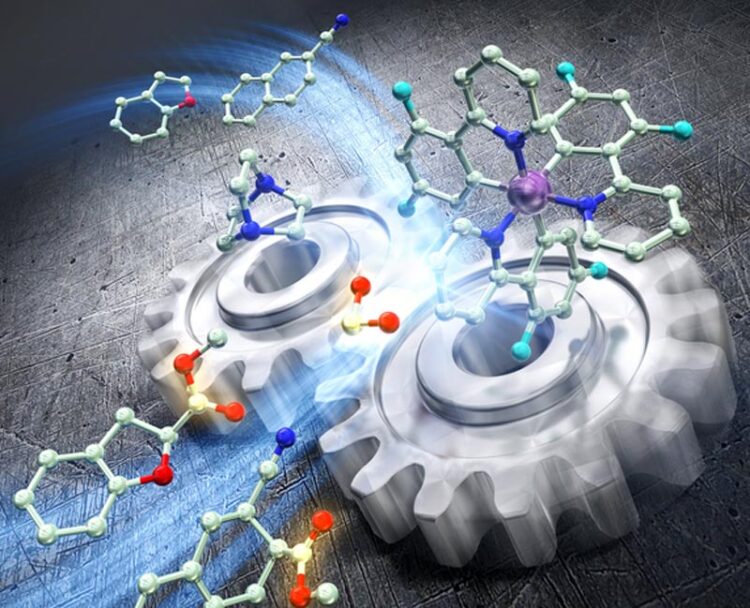It takes two: cooperating catalysts provide new route for utilizing formate salts

Depiction of blue light irradiation and two ‘catalyst gears’ cooperating to enable a reaction.
Credit: Tsuyoshi Mita
Two catalysts working in tandem enable inexpensive formate salts to perform difficult dearomative reactions, giving products potentially useful for drug development.
Researchers at the Institute for Chemical Reaction Design and Discovery (WPI-ICReDD) have developed a method that uses cooperating catalysts to carry out challenging dearomative carboxylation reactions. In this process, highly reactive carbon dioxide (CO2) radical anions are derived from inexpensive formate salts and used to produce a variety of products, including α-amino acids, which are potentially useful in drug development.
Aromatic systems are stable, so carrying out a dearomative reaction, where the aromatic system is disrupted, requires a highly reactive compound. In this study, a formate salt compound is used as the source of highly reactive CO2 radical anions. Researchers designed the reaction such that two separate catalysts, a photoredox catalyst and a hydrogen atom transfer catalyst, cooperate with each other. This cooperation, combined with exposure to blue light, generates highly reactive CO2 radical anions that can add themselves to an aromatic system, disrupting the aromatic system in the process.
Previous research from this group that used electricity to drive a similar reaction provided inspiration for this study.
“Based on computations from a previous electrochemical reaction that we studied, we suspected a reaction mechanism using CO2 radical anions would be promising,” commented first author Saeesh Mangaonkar. “This time, we came up with a photochemical approach which is environmentally friendly and suitable for commercially available aromatic compounds.”
In addition to standard all-carbon aromatic rings, this dearomative carboxylation reaction framework was shown to be successful for a wide variety of heteroaromatic rings, which feature an oxygen, nitrogen or sulfur atom in the ring instead of one of the carbon atoms. The resulting carboxylic acid derivatives have non-carbon atoms neighboring the acid part of the molecule, and this is an important structural feature. With additional steps, these types of compounds can be transformed into biologically active structures, making the process developed in this study a highly useful transformation.
While the previous method adds two CO2 molecules to the substrate, this new method adds only a single CO2 molecule derived from formate salts. With these two complementary methods, chemists can now control whether they add one or two CO2 molecules, enabling greater freedom when designing and synthesizing molecules with carboxyl groups.
“We are hoping this process will prove useful in pharmaceutical development,” added Tsuyoshi Mita. “Creating efficient synthesis methods such as this one is important for working towards a sustainable society.”
Journal: ACS Catalysis
DOI: 10.1021/acscatal.2c06192
Method of Research: Experimental study
Subject of Research: Not applicable
Article Title: Photoredox/HAT-catalyzed dearomative nucleophilic addition of the CO2 radical anion to (Hetero)aromatics
Article Publication Date: 3-Feb-2023
Media Contacts
Sohail Keegan Pinto
Hokkaido University
en-press@general.hokudai.ac.jp
Office: +81-11-706-2186
@HokkaidoUni
Collin Stecker
Institute for Chemical Reaction Design and Discovery (WPI-ICReDD), Hokkaido University
public_relations@icredd.hokudai.ac.jp
Office: +81-11-706-9646
@ICReDDConnect
All latest news from the category: Life Sciences and Chemistry
Articles and reports from the Life Sciences and chemistry area deal with applied and basic research into modern biology, chemistry and human medicine.
Valuable information can be found on a range of life sciences fields including bacteriology, biochemistry, bionics, bioinformatics, biophysics, biotechnology, genetics, geobotany, human biology, marine biology, microbiology, molecular biology, cellular biology, zoology, bioinorganic chemistry, microchemistry and environmental chemistry.
Newest articles

Innovative 3D printed scaffolds offer new hope for bone healing
Researchers at the Institute for Bioengineering of Catalonia have developed novel 3D printed PLA-CaP scaffolds that promote blood vessel formation, ensuring better healing and regeneration of bone tissue. Bone is…

The surprising role of gut infection in Alzheimer’s disease
ASU- and Banner Alzheimer’s Institute-led study implicates link between a common virus and the disease, which travels from the gut to the brain and may be a target for antiviral…

Molecular gardening: New enzymes discovered for protein modification pruning
How deubiquitinases USP53 and USP54 cleave long polyubiquitin chains and how the former is linked to liver disease in children. Deubiquitinases (DUBs) are enzymes used by cells to trim protein…



